#Delta of Venus 1995
Explore tagged Tumblr posts
Text



Delta of Venus (1995) | Dir. Zalman King
#Delta of Venus#Delta of Venus 1995#Zalman King#Audie England#Costas Mandylor#Film#Movies#Gifs#anitaoriginal#When she pulls back just to touch his lips with her thumb.......
1K notes
·
View notes
Text

Raven Snow in Delta of Venus (1995).
52 notes
·
View notes
Text






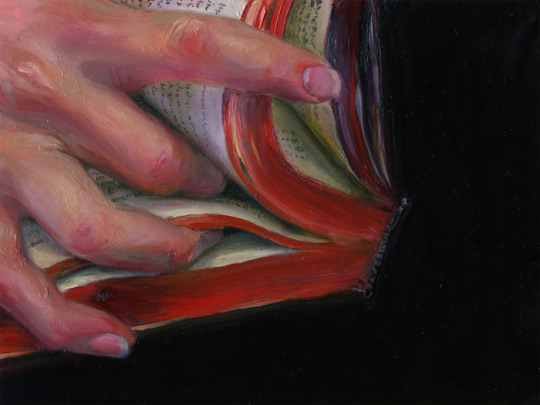

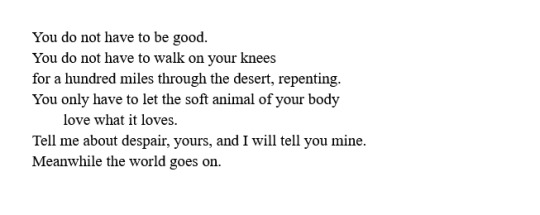



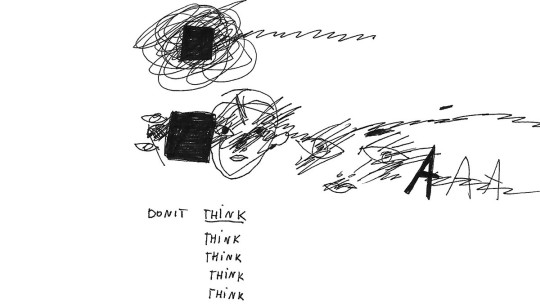
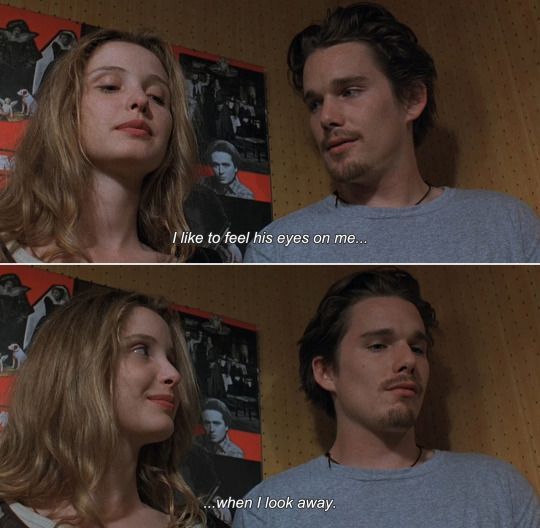


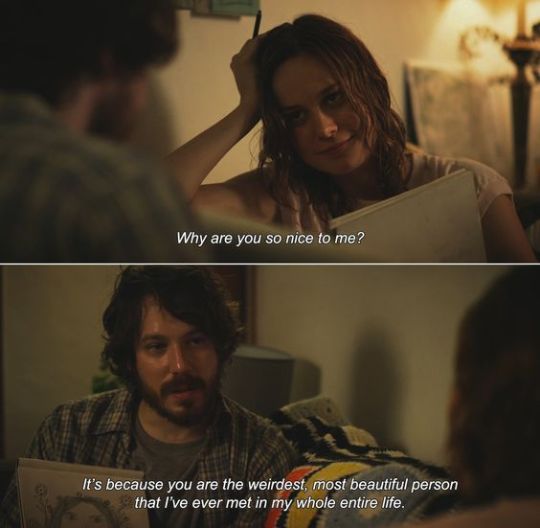

web weave for will g.raham and d.ana s.cully, for @beyondthescully
how to be a person in the world by heather havrilesky // side effects (2013) // untitled by aleksandra gittsigrat // sue zhao // art by teraoka natsumi & quote by edouard boubat // freckles by kevin atwater // red letter 5 by jen mazza // red letter 4 by jen mazza // wild geese by mary oliver // daniel horowitz // mystery by jesse jo // karolina koryl // karolina koryl // before sunrise (1995) // in her arms by malcolm liepke // delta of venus by anaïs nin // short term 12 (2013) // sweet by cigarettes after sex
5 notes
·
View notes
Text
delta of venus (1995) is so bad it doesn't even feel like anaïs nin at all
6 notes
·
View notes
Text

I want this out of my drafts
10 notes
·
View notes
Text
1 note
·
View note
Text



Delta of Venus (1995) | Dir. Zalman King
#Delta of Venus#Delta of Venus 1995#Zalman King#Audie England#Costas Mandylor#Film#Movies#Gifs#anitaoriginal#I learned how to make gifs!#So I needed to show one of my favorite.... scenes of late#These don't look great but I'm learning#But I also don't think I'll be doing too many sets in the future#I'm a stills girl at heart
182 notes
·
View notes
Text





Delta of Venus (1995) | Dir. Zalman King
#Delta of Venus#Delta of Venus 1995#Zalman King#Costas Mandylor#Film#Movies#Gifs#anitaoriginal#Only made this for the tongue part tbh#But we also need to appreciate men who eat out
69 notes
·
View notes
Photo
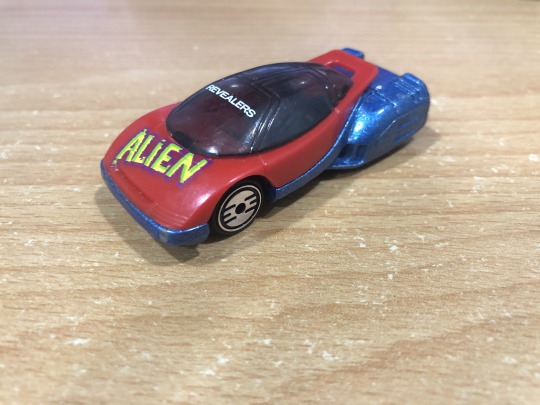
That Time Forgot: IAD Alien (and related concepts)
I gotta admit. For the longest time, I thought that this car, with its supremely space-age design, was not real. But after a bit of a search and some other things... I found it was. I believe some people might share this sentiment. Today, I’m going to talk about the history behind the IAD Alien, along with, as a bonus, all of the other things IAD made over the years.

IAD, or International Automotive Design, was a British design company founded in 1976 by husband and wife Yvonne and John Shute. The company originally designed bodies for trains (my other interest), but eventually branched out to designing bodies for automobiles. Increasing demand eventually caused IAD to branch out to encompassing various different facets of the industry, from design and sculpting models to small-scale production. In the 1980s, IAD was one of the biggest automotive design firms in the world, competing against such giants like Bertone, Italdesign and of course, Pininfarina, and also had multiple facilities around the world.
Touted as “Britain’s Largest Styling Company”, IAD meant business. To prove that they were a force in the industry, they designed a number of concept cars throughout the 1980s to early 1990s, and we’ll be talking about them here. I will not be counting cars that were designed by IAD, but manufactured by another company.
The first of the concept cars they designed was known as the TRX.

The TRX was a radical restyling of the Triumph TR7, designed by Martin Longmore. The TRX attempted to make the car have a completely different appearance, but keeping the fundamental structure of the car as close as possible to the TR7. General Electric Plastics helped to fund the project. It was displayed at the 1980 Birmingham Motor Show.
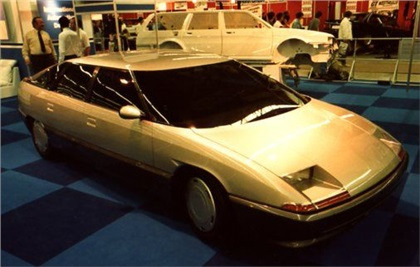
Their next project was the Arrival, displayed at the 1985 Frankfurt Motor Show. The car attempted to demonstrate IAD’s expertise with computer-aided design, showing a proposal for a five-door sedan designed entirely with a computer.

The next car IAD would design would turn out to be arguably their most famous design yet, helped by the fact that a Hot Wheels model was produced replicating the car: the Alien.

The IAD Alien was designed by Longmore and Marcus Hotblack, and was their proposal for a futuristic mid-engined supercar. Featuring a canopy door which tilted forward for unhindered entrance and egress, the Alien showcased a number of interesting solutions for the general public. The car was first introduced at the 1986 Turin Motor Show.

The car itself featured a highly sophisticated interior with a starship-like steering wheel and heads-up display for the dashboard. The interior was also well-protected, with an integrated roll cage in the car. Quite possibly the most interesting part of the car was its modularity; owners of the car could switch out engines on the fly for easy upgrading, maintenance or to change to something else the driver suited. A bit over the top, yes, but that’s what the ‘80s were like.

Unfortunately, the car was non-functional, and Longmore and Hotblack would move on to their next project.
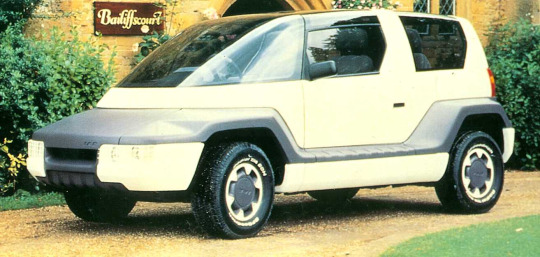
The Impact was their next project, also designed by Longmore and Hotblack. Built on a Ford Sierra chassis and powered by a 2.8L Cologne V6, the Impact aimed to be one of the most barrier-free SUVs possible, with folding steps when any of the doors opened. A split tailgate and underfloor storage allowed the Impact to store more than a usual SUV could. It was branded as a Sports/Utility Car by a brochure, and featured an in-car navigation system. The car was showcased at the 1987 Frankfurt Motor Show.

To add to their SUV portfolio, IAD did up the Interstate. Designed by Tony Pettman, the usual Ford Cologne V6 was fitted underneath a soundproof cover, allowing for some of the quietest rides. It too, like the Impact, was introduced at the 1987 Frankfurt Motor Show.

Following up the Impact was the Hunter, a rugged off-road vehicle equipped with navigational systems and a telephone. Appearing very similarly to the Impact, the Hunter was also fitted with the same Ford Cologne V6 and featured weatherproof seats made out of foam. It was showcased at the 1988 Turin Motor Show, and was designed by Longmore, Hotblack and Dave Ancona.

After the Hunter came the Royale, designed by Bill Barranco and Jose Diaz de la Vega. The Royale was built around a highly modified Subaru XT-6, with the wheelbase stretched. Meant for business executives, the Royale had a rotary keypad and controls for the CD player and satnav systems available to both rear passengers. The headlights and taillights were engineered by Phillips (yes, that Phillips), and featured a massive LED screen in the rear of the car integrated with the taillamps engineered to give various pieces of road safety information. It, like the Hunter, was also shown off at the 1988 Turin Auto Show.

Their next car was the rather interesting-looking (and potentially rather unsightly) Venus. Introduced at the 1989 Tokyo Motor Show, the Venus was designed by Michael Ani and touted as a futuristic supercar with both performance and a distinctive appearance. The design aimed to form a blend between the technical and aesthetic aspects of the car. A functioning model of the car was eventually built on a Lotus Elise chassis.

Their next project was simply titled the Mini MPV. Powered by a Ford Escort’s CVH 1.9L engine, the Mini MPV could seat six people in three rows. It debuted at the 1990 Turin Motor Show and may have been trialed at Los Angeles International Airport at the time.

Okay, I’m breaking the “outsourced production” rule, but technically this thing was designed by IAD but never produced, so it sort of qualifies. This is the IAD Magia (or Lancia Magia), designed by Ani and Brian Osborn. Featuring the 2.0L FIAT Twin-Cam inline-4 from a Lancia Delta Integrale, the Magia featured a “svelte body” on top of a Lancia Dedra platform, and was touted as “a car to capture the imagination of all the devotees of sporting coupes”. The car was shown off at the 1992 Turin Auto Show, where it was extremely well received, although serial production never materialized.
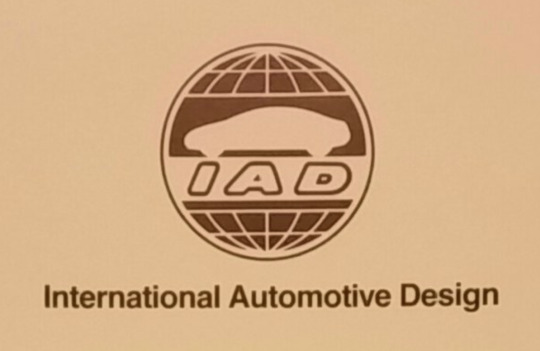
Reeling from the effects of the European Union’s automobile industry’s worst recession, IAD went into receivership and was acquired by Mayflower Group in 1993. John Shute would die two years later on 13 January 1995, aged 54. Despite his death, IAD would go on to design one more concept on their own.

That design was the EuroTaxi. This was a taxi designed to be the cheapest and most efficient taxi to operate by miles. The EuroTaxi attempted to extend service intervals through the use of both an internal combustion engine and an onboard battery pack, and as a result, decrease downtime. The car was showcased at the 1995 Frankfurt Motor Show, but of course, no orders were placed. The EuroTaxi would turn out to be IAD’s last design.

With the money running dry due to said recession, Britain’s Leading Styling Company were forced to release their chokehold on the car design industry and vanished. The company’s design facilities were bought over by Daewoo Motors, and IAD faded into obscurity, never to be heard from again, while Pinifarina, Bertone and Italdesign are still around today, designing cars.
Okay, now that we’ve gotten the history of IAD out of the way, let’s talk about what you came for: the Hot Wheels version of the IAD Alien.

The Alien was designed by Larry Wood and first introduced in the 1989 Speed Fleet series in the above color, somewhat replicating that of the real Alien; however, this color is quite rare and was quickly replaced by the far more common red version. The casting never received any mention of IAD on it; for all its releases it was simply titled “Alien”.

The Alien features a plastic wraparound body rivited to the base, with metal fender flares and a plastic canopy. This canopy can theoretically be removed, but I’m not going to attempt to do so; instead, I’ll show a picture of one with the canopy removed.

The casting has a metal base, which makes this casting quite heavy. It actually has some decent details on the undercarriage.

The base features few markings apart from the logo and copyright information. I can honestly see people not being able to identify this car, but this was at a time where little other information other than copyright and the Hot Wheels logo was placed on the base; this lasted from about the mid-’80s to the mid-to-late-’90s, at which point it was presumably mandated to put the name of the casting on the base unless it couldn’t fit.
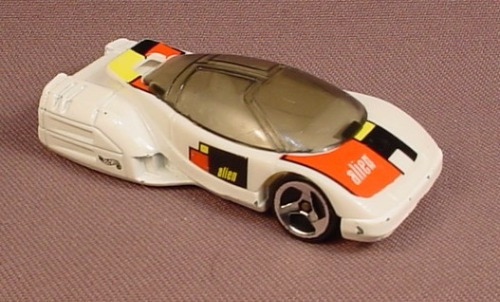
The Alien enjoyed the privilege of being released quite often when it was in the lineup, but ultimately this casting was doomed in 1999 for one reason, and one reason only: the Final Run Series.

The Final Run Series started in 1999 and acted as what I would consider a very glorified funeral for a casting; Hot Wheels would give these cars special tires and paint, in exchange for vowing to never produce them again by cutting their toolings in half. The Alien was unfortunately one of the castings to fall victim to the Final Run Series, and although it might not have been one of the more popular castings to retire that year, it was still retired regardless. As the first batch of cars to be Final Run, having been introduced in the 1999 series, the Alien will never be seen again in the Hot Wheels lineup unless a new tool and die is created for it, which I believe is highly unlikely. The Final Run Series itself has been on hiatus since 2006. In total, the Alien had fifteen releases.

Always on the receiving end of very loud decals due to its plastic sides and large fenders, the Alien will be dearly missed (by me, at least) in the Hot Wheels lineup, and I wouldn’t mind seeing a modern recreation of the Alien return to the Hot Wheels lineup as a premium piece.

I hope this post has given you a better idea on the history of this futuristic British supercar concept, and the history of its small Hot Wheels counterpart. As usual, I’d write something like this any day.
- Grunty
3 notes
·
View notes
Photo


I was scanning pages of the Spring 1995 edition of Industrial Nation, this morning, and I came across a review of Delta of Venus - Dark With Fire. So I grabbed this out of the drawer.
While we sold the cassette at my old record store I got my copy (and this #tshirt) from a trivia question Rexx Arkana asked at the club. I don't remember the question because we were celebrating my birthday and tequila was on special all night #drunkgoth #totd #ootd #itsagoodalbum #goth#gothmusic
#t-shirt#ootd#totd#shade#Delta of Venus#the first album has his girlfriend's vagina on the J-card#for some reason he got all bent when you said you liked it#selfie#industrial nation#goth music
1 note
·
View note
Text




Delta of Venus (1995) | Dir. Zalman King
#Delta of Venus#Delta of Venus 1995#Zalman King#Audie England#Costas Mandylor#Film#Movies#Gifs#anitaoriginal#His ass is unfair
59 notes
·
View notes
Photo


Randy Weston, Pianist Who Traced Roots of Jazz to Africa, Dies at 92
Randy Weston, an esteemed pianist whose music and scholarship advanced the argument — now broadly accepted — that jazz is, at its core, an African music, died on Saturday at his home in Brooklyn. He was 92.
His death was confirmed by his lawyer, Gail Boyd.
On his earliest recordings, in the mid-1950s for the Riverside label, Mr. Weston almost fit the profile of a standard bebop musician: He recorded jazz standards and galloping original tunes in a typical small-group format. But his sharply cut harmonies and intense, gnarled rhythms conveyed a manifestly Afrocentric sensibility, one that was slightly more barbed and rugged than the popular hard-bop sound of the day.
Early on, he exhibited a distinctive voice as a composer. “Hi-Fly,” which he first released in 1958 on the LP “New Faces at Newport,” became a standard. And he eventually distinguished himself as a solo pianist, reflecting the influence of his main idol, Thelonious Monk.
But more than Monk, Mr. Weston liked constantly to reshape his cadences, rarely lingering on a steady pulse.
Reviewing a concert in 1990, Peter Watrous of The New York Times wrote of Mr. Weston, “Everything he played was edited to the essential notes of a phrase, and each phrase stood on its own, carefully separated from the next one; Mr. Weston sat rippling waves of notes down next to glossy and percussive octaves, which led logically to meditative chords.”
At 6 feet 7 inches tall, often favoring flowing garments from North or West Africa, Mr. Weston was an imposing, though genial, figure whether performing onstage or teaching in university classrooms. Even before making his first album, he was giving concerts and teaching seminars that emphasized the African roots of jazz. This flew in the face of the prevailing narrative at the time, which cast jazz as a broadly American music, and as a kind of equal-opportunity soundtrack to racial integration.
“Wherever I go, I try to explain that if you love music, you have to know where it came from,” Mr. Weston told the website All About Jazz in 2003. “Whether you say jazz or blues or bossa nova or samba, salsa — all these names are all Africa’s contributions to the Western Hemisphere. If you take out the African elements of our music, you would have nothing.”
As countries across Africa shook themselves free of colonial exploitation in the mid-20th century, Mr. Weston recorded albums that explicitly saluted the struggle for self-determination. “Uhuru Afrika” (the title is Swahili for “Freedom Africa”), released in 1960, included lyrics written by Langston Hughes, and sales were banned in South Africa by its apartheid regime.
That album — and others throughout his career — featured the marbled horn arrangements of the trombonist Melba Liston, who left an indelible stamp on Mr. Weston’s oeuvre.
In 1959 he became a central member of the United Nations Jazz Society, a group seeking to spread jazz throughout the world, particularly in Africa. In 1961 he visited Nigeria as part of a delegation of the American Society for African Culture, beginning a lifelong trans-Atlantic exchange.
After two more trips to Africa, he moved to Morocco, in 1968, having first arrived there on a trip sponsored by the State Department. He stayed for five years, living first in Rabat and then in Tangier, where he ran the African Rhythms Cultural Center, a performance venue that fostered artists from various traditions.
Mr. Weston drew particular inspiration from musicians of the Gnawa tradition, whose music centered on complex, commingled rhythms and low drones. While in Morocco he established a rigorous international touring regimen and played often in Europe.
In the late 1980s and early ’90s, Mr. Weston released a series of high-profile recordings for the Verve label, all to critical acclaim. Those included tributes to his two greatest American influences, Duke Ellington and Monk, as well as a record dedicated to his own compositions, “Self Portraits,” from 1989.
Mr. Weston earned Grammy nominations in 1973 for his album “Tanjah” (for best jazz performance by a big band), and in 1995 for “The Splendid Master Gnawa Musicians of Morocco” (in the best world music album category), a recording that he produced and released under his name but on which he left most of the playing to 11 Moroccan musicians.
In 2001, the National Endowment for the Arts gave Mr. Weston its Jazz Masters award, the highest accolade available to a jazz artist in the United States. He was voted into DownBeat magazine’s hall of fame in 2016.
Randolph Edward Weston was born in Brooklyn on April 6, 1926. His father, Frank, was a barber and restaurateur who had emigrated from Panama and studied his African heritage with pride. His mother, Vivian (Moore) Weston, was a domestic worker who had grown up in Virginia.
Though his parents split up when he was 3, they stayed on good terms and lived near each other in Brooklyn. Randy spent time with both throughout his childhood, receiving his father’s teachings about the cultures of Africa and the Caribbean while absorbing the music of the African-American church from his mother, who made sure that Randy and his half sister, Gladys, were in the pews every Sunday.
In his memoir, “African Rhythms” (2010), written with Willard Jenkins, Mr. Weston recalled that his father — a supporter of Marcus Garvey’s Universal Negro Improvement Association — hung “maps and portraits of African kings on the walls, and was forever talking to me about Africa.”
Mr. Weston wrote of his father, “He was planting the seeds for what I would become as far as developing my consciousness of the plight of Africans all over the world.”
Mr. Weston took classical piano lessons as a child but did not fall in love with the instrument until he started studying with a teacher who encouraged his already growing interest in jazz, particularly the music of Ellington, Count Basie and the saxophonist Coleman Hawkins.
Mr. Weston was drafted into the Army in 1944 while World War II was underway, serving three years in an all-black unit under the military’s segregationist policies and rising to staff sergeant. While stationed in Okinawa, Japan, he was in charge of managing supplies, and frequently tried to share leftover materials and food with local residents, many of whom had lost their homes in the war.
Upon returning to Brooklyn, he took over managing his father’s restaurant, Trios, which became a hub of intellectuals and artists. Mr. Weston began playing jazz and R&B gigs in the borough, seeking wisdom from older musicians. He became particularly close to Monk.
“When I heard Monk play, his sound, his direction, I just fell in love with it,” Mr. Weston told All About Jazz in 2003. “I would pick him up in the car and bring him to Brooklyn, and he was a great master because, for me, he put the magic back into the music.”
Heroin use was rampant on the jazz scene then, and Mr. Weston sometimes used the drug, though he never developed a full-blown addiction. In 1951 he left New York, seeking a fresh start in Lenox, Mass. He made frequent trips to the Music Inn, a venue in nearby Stockbridge, and while working there he met Marshall Stearns, a leading jazz scholar with strong beliefs about jazz’s West African roots, who was giving lectures and leading workshops there.
Mr. Weston started to perform regularly, and he and Mr. Stearns collaborated on a series of round tables about the history of jazz. Mr. Weston met musicians from across the African diaspora, including the Nigerian drummer Babatunde Olatunji, the Cuban percussionist Cándido Camero and the Sierra Leonean drummer Asadata Dafora.
When he returned to Brooklyn, he was brimming with ideas about the synchrony of African tradition and jazz innovation.
He later received fellowships from the Guggenheim Foundation, the Doris Duke Charitable Foundation and United States Artists, as well as awards from the Moroccan government and the Institute of the Black World.
He held honorary doctorates of music from Brooklyn College, Colby College and the New England Conservatory, and had served as artist in residence at universities around New York City. Mr. Weston’s papers are archived at Harvard University’s Hutchins Center for African & African American Research.
He is survived by his wife, Fatoumata Mbengue; three daughters, Cheryl, Pamela and Kim; seven grandchildren; six great-grandchildren; and one great-great-grandchild. Mr. Weston’s first marriage, to Mildred Mosley, ended in divorce. A son, Azzedin, is deceased.
Mr. Weston remained in good health late in life, performing most often with a rotating group he called African Rhythms.
In 2016, he released his 50th and final album as a bandleader, the two-disc “African Nubian Suite,” which featured an orchestra-size iteration of African Rhythms. Through music and spoken word, the suite traces humanity’s origins back to the Nile River delta.
His last public concert was in July at the Nice Jazz Festival in France, with his African Rhythms Quintet. At his death, his website listed performances scheduled through October.
For Mr. Weston, music was a way of connecting histories with the present, and a communal undertaking. Looking back on his career, he told All About Jazz: “I have been blessed because I have been around some of the most fantastic people on the planet. I have become a composer and become a pianist. I couldn’t ask for anything more.”
Photographs:
Randy Weston performing in 1963
Randy Weston at the Newport Jazz Festival in 2011
#randy weston#rip#the new york times#jazz#music#black music#african music#pianist#pianists#black pianist#black pianists#afrocentricity#united nations jazz society#uhuru afrika#freedom africa#panamanian#duke ellington#thelonious monk#marcus garvey#brooklyn#new york city#universal negro improvement association#randolph edward weston
2 notes
·
View notes
Text
Harrington to join Hall of Master Folk Artists

NATCHITOCHES – Long time Natchitoches musician, songwriter and philanthropist Rodney Harrington, singer for Johnny Earthquake and the Moondogs, will be inducted into the Louisiana Folklife Hall of Master Folk Artists at the 39th Annual Natchitoches-NSU Folk Festival which will be held on July 20-21 in Prather Coliseum on the Northwestern State University campus. In addition to being inducted into the Hall of Master Folk Artists, Harrington will perform at the Festival. On the evening of July 21 Harrington will appear along with Rock & Roll Hall of Famer guitarist James Burton, Estelle Brown of the Sweet Inspirations and Grammy winner and Cajun folk artist Jo-El Sonnier, as guests of Johnny Earthquake and The Moondogs in the Festival’s grand finale concert. The concert will include a tribute to Elvis Presley featuring a recreation of the King’s Vegas-style show.
“We are honored to induct Rodney Harrington into the Hall of Master Folk Artists,” said Dr. Shane Rasmussen, director of the Louisiana Folklife Center and the Natchitoches-NSU Folk Festival. “He is not only a great musician, but his philanthropic efforts have benefited so many throughout the state. Audiences throughout the South respond so powerfully to the music of the Moondogs because of the band’s love for Louisiana culture and music. As leader of the Moondogs, Rodney has been a phenomenal cultural ambassador for Natchitoches and Louisiana.”
Harrington has been involved in music his entire life and has been an active part of the Natchitoches and Louisiana music scene for more than 30 years. During that time, Harrington’s contribution to Louisiana’s regional roots and original music have been in his various capacities as a performer, song writer, producer, attorney, concert and festival promoter and organizer, philanthropist and radio host.
Harrington helped form a popular Natchitoches group in the late 1980s called Dick Dante and the Infernos which performed for several years. In 1995, Harrington and some friends formed the group Johnny Earthquake and the Moondogs. Over their nearly 25 years of existence, the Moondogs have become a popular band not only in the Natchitoches area, but across the South. Under Harrington’s leadership, the Moondogs have managed to constantly change members (over 60 musicians have been members of the band over the years) while steadily increasing in popularity. The Moondogs have garnered numerous awards and been called by City Lights Entertainment Magazine “Quite simply Louisiana’s best show band.” Offbeat Magazine of New Orleans, a Louisiana roots magazine, in its review of one of the Moondogs’ critically acclaimed albums has observed “Tradition never sounded so good.” Harrington has written and recorded several Louisiana and Natchitoches flavored original songs. One of them, Cane River Blues, was featured in a Hollywood movie. Various compilation albums include his songs, such as “Hey Santa” which was featured on the recent The Very Best of Louisiana Christmas, a compilation released by the Louisiana Music Hall of Fame, with songs by Fats Domino, Aaron Neville, Dr. John, Brittney Spears and other Louisiana artists. Harrington’s music related philanthropic activities have been numerous. He helped organize and for several years has served on the board of the James Burton Foundation which has provided hundreds of guitars for school children, veterans and their families and ailing children in hospitals. The Foundation has also started music programs in schools that would not otherwise have them. Harrington has also served on the board of The Friends of the Municipal Auditorium, which worked on the preservation of that historic venue and on the Board for the Ark La Tex Music Heritage Foundation, which raises money to purchase musical instruments for schools. For several years, Harrington has served as the chairman of the board for the Natchitoches Jazz and R&B Festival. Under Harrington’s leadership, the Festival has grown over the years to become one of the more popular music festivals in Louisiana and the South. Harrington has often helped raise money for the Northwestern State University Department of Music. When the Natchitoches Central High School Orchestra needed funds to go to Carnegie Hall, Harrington organized and produced a fundraising concert which raised thousands of dollars for the trip which made it possible for many students to make the trip who otherwise would not have been able to. When Natchitoches blues artist Hardrick Rivers needed a prosthetic leg, Harrington came up with an idea for a concert called HardrickFest, which he organized and produced to raise money to purchase a prosthetic leg for Hardrick. For the past 20 years, Harrington has hosted the syndicated radio show “Jammin’ With Johnny—The Johnny Earthquake Show.” The show, which is broadcast over much of Louisiana and into East Texas, has been rated number one in its timeslot. In addition to spotlighting and promoting area community cultural events, the show often features interviews with artists and live music in the studio featuring local and area artists. “Jammin With Johnny” is believed to be the only radio program in North and Central Louisiana that features live music on a regular basis.
The Festival will be held in air-conditioned Prather Coliseum located at 220 South Jefferson Street on the NSU campus in Natchitoches. The Festival will be held Friday, July 20 from 4:30 p.m. until 10:15 p.m. and all day on Saturday July 21 from 8 a.m. until 10:00 p.m.. The family-oriented festival is wheelchair accessible. Children 12 and under are admitted free of charge. For a full schedule of events, to purchase tickets or for more information call (318) 357-4332, send an email to [email protected], or go to louisianafolklife.nsula.edu.
Support for the Fiddle Championship and the Festival is provided by grants from the Cane River National Heritage Area, Inc., the Louisiana Division of the Arts Decentralized Arts Fund Program, the Louisiana Office of Tourism, the Natchitoches Historic District Development Commission, the National Endowment for the Arts, the New Orleans Jazz and Heritage Festival and Foundation and the Shreveport Regional Arts Council.
The Festival is also supported by generous sponsorships from Acme Refrigeration of Baton Rouge, Dr. James Arceneaux, Bank of Montgomery, Louie Bernard, City Bank, the City of Natchitoches, Cleco, John Conine; Corkern, Crews, Johnson & Guillet; CP-Tel, Delta Car Wash, Dan and Desirée Dyess, Georgia’s Gift Shop, La Capitol FCU, the Harrington Law Firm, Billy Joe Harrington, Jeanne’s Country Garden, Maglieaux's Riverfront Restaurant, the Natchitoches Area Convention & Visitors Bureau, Natchitoches Wood Preserving, Inc., NSU Men’s Basketball, Page Builders, LLC, Sabine State Bank, R.V. Byles Enterprises, UniFirst, Dr. Michael Vienne, David and Shirley Walker, Waste Connections and Young Estate LLC.
2 notes
·
View notes


